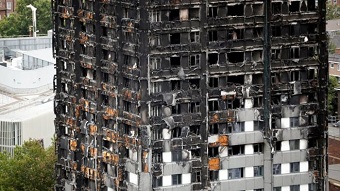Eighty-two buildings have failed a new fire safety test set up in the wake of the Grenfell Tower fire, ministers say. The test examines the safety of building cladding and insulation in combination. It comes as an independent review of building regulations and fire safety has also been announced by the government. It will look at current building regulations and fire safety, focusing on high-rise residential buildings. The fire at Grenfell Tower block on 14 June in North Kensington, London, killed at least 80 people.
Of the 82 buildings that failed the latest test, 47 are local authority or housing association-owned or managed. The new fire safety test is the first of a wave of more comprehensive assessments, which come after previous tests were carried out on hundreds of cladding samples in recent months – many of these failed standards for flammability.
The government says these new “whole system” tests simulate tall buildings by testing the insulation and cladding materials in conjunction with one another when set on fire.
Nine blocks in Salford are among those who failed the latest tests. They are currently having their cladding system removed and replaced, the city council has said.
Jay Loftus, a former firefighter living in one of the Salford towers, told BBC 5 live that the council was “quoting two years to take this stuff off. There are nine blocks and we are into tens of millions of pounds”. He said he did not feel safe in the tower block. “The attitude has been that it’s a rolling programme of two years [to take cladding down]. What happens in between?” The independent review will be led by Dame Judith Hackitt, of the Manufacturers’ Organisation. It will report report jointly to Communities Secretary Sajid Javid and Home Secretary Amber Rudd.
The review will examine:
• the regulatory system around the design, construction and on-going management of buildings in relation to fire safety
• compliance and enforcement issues
• international regulation and experience in this area








